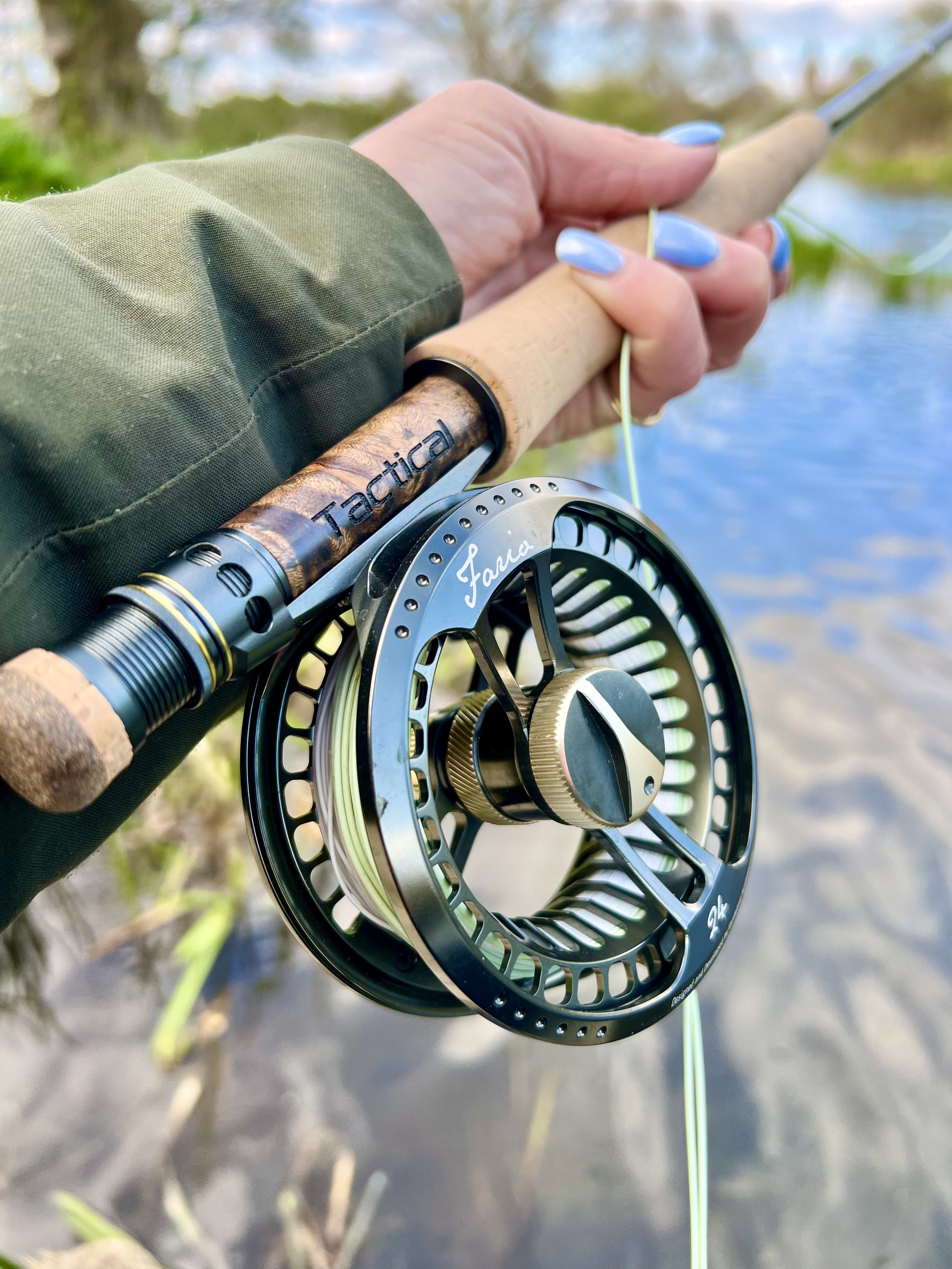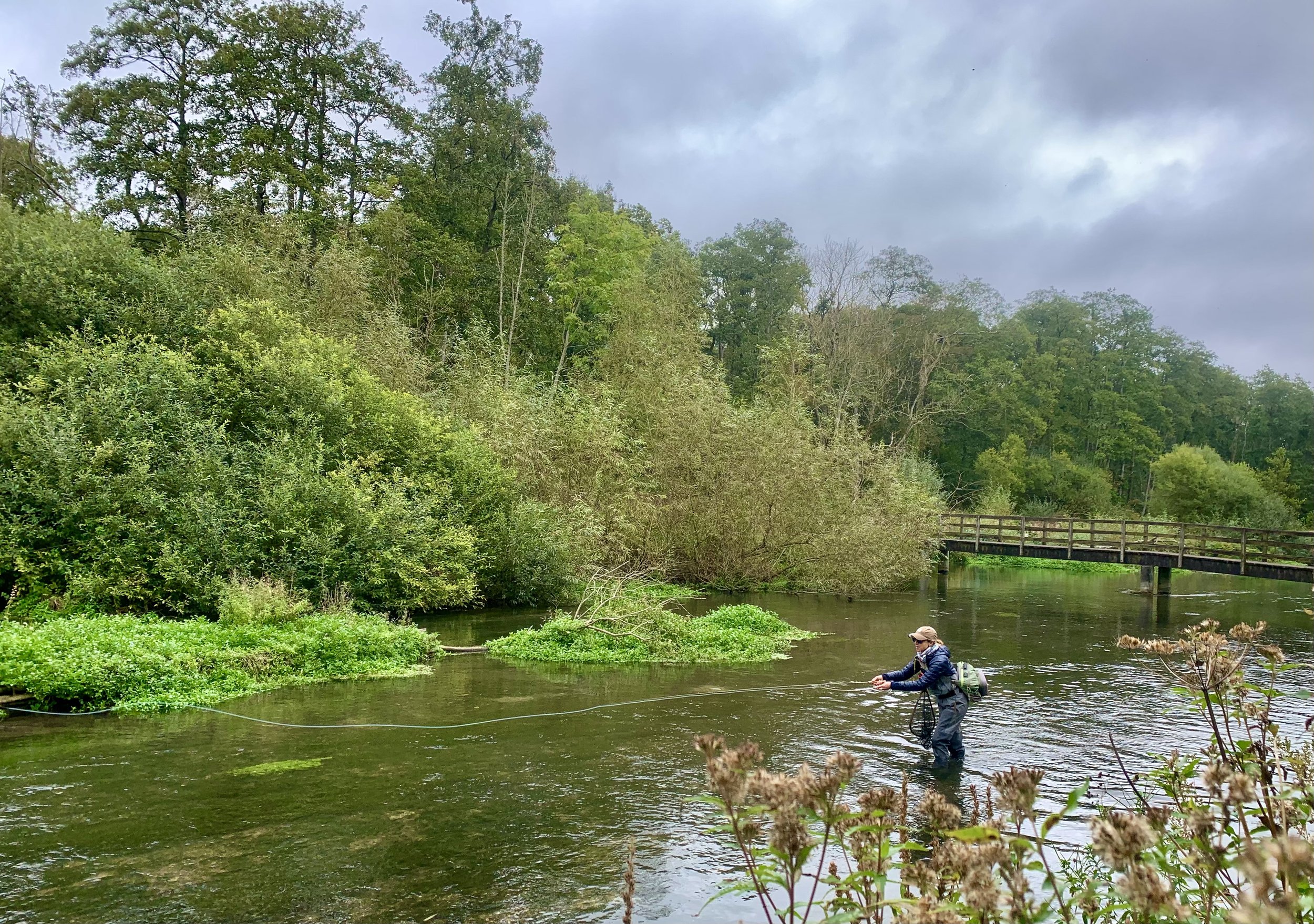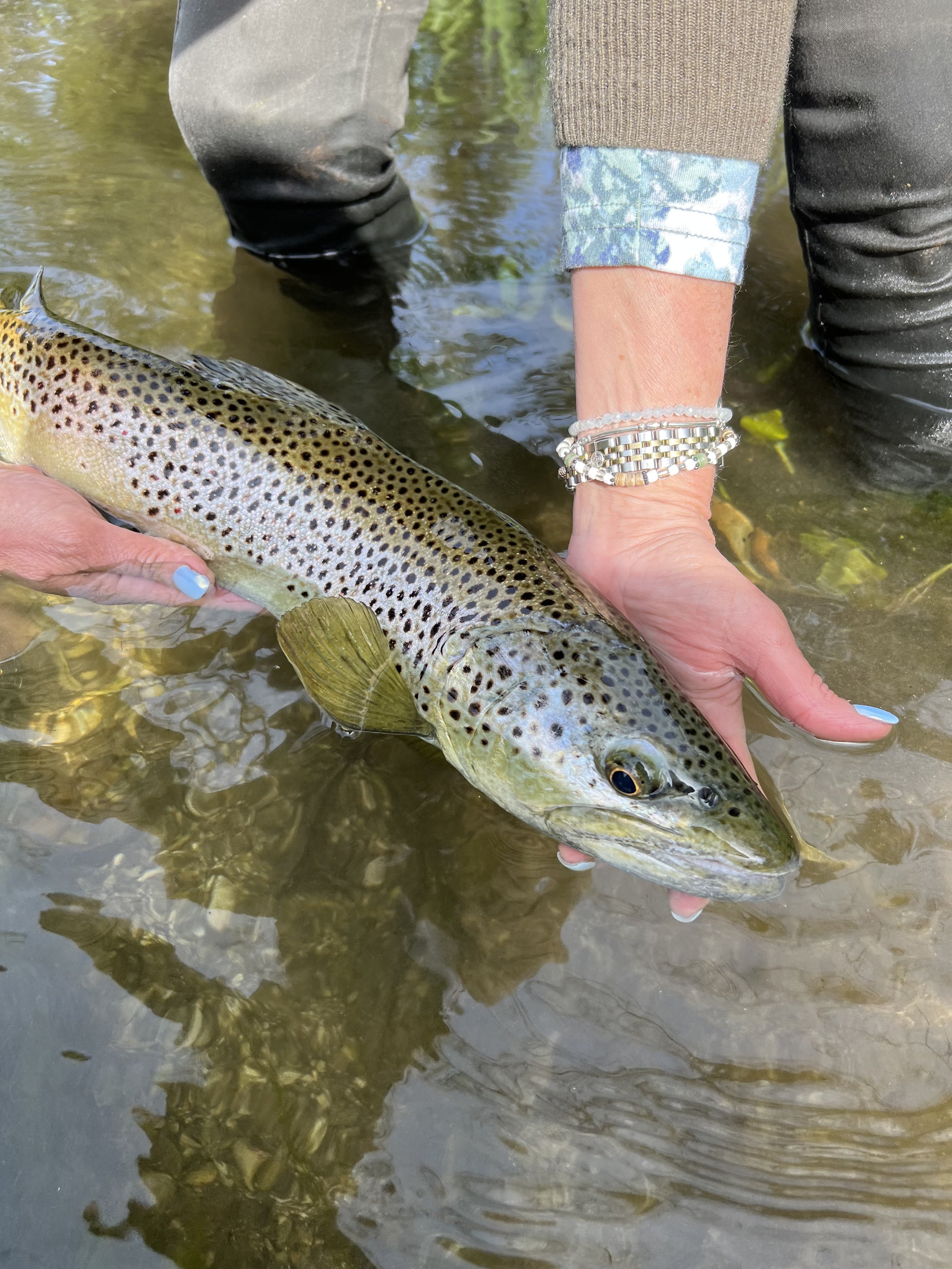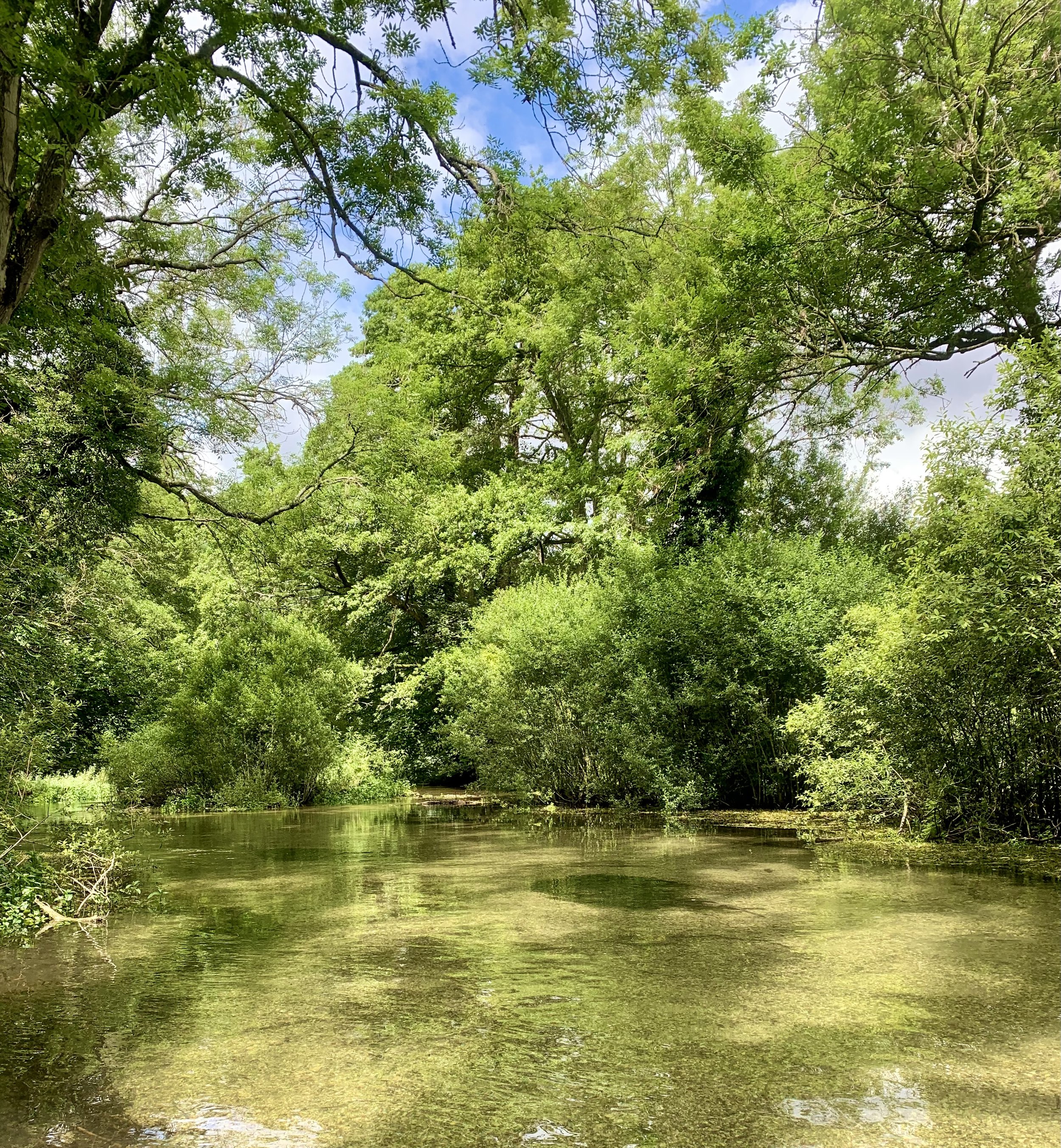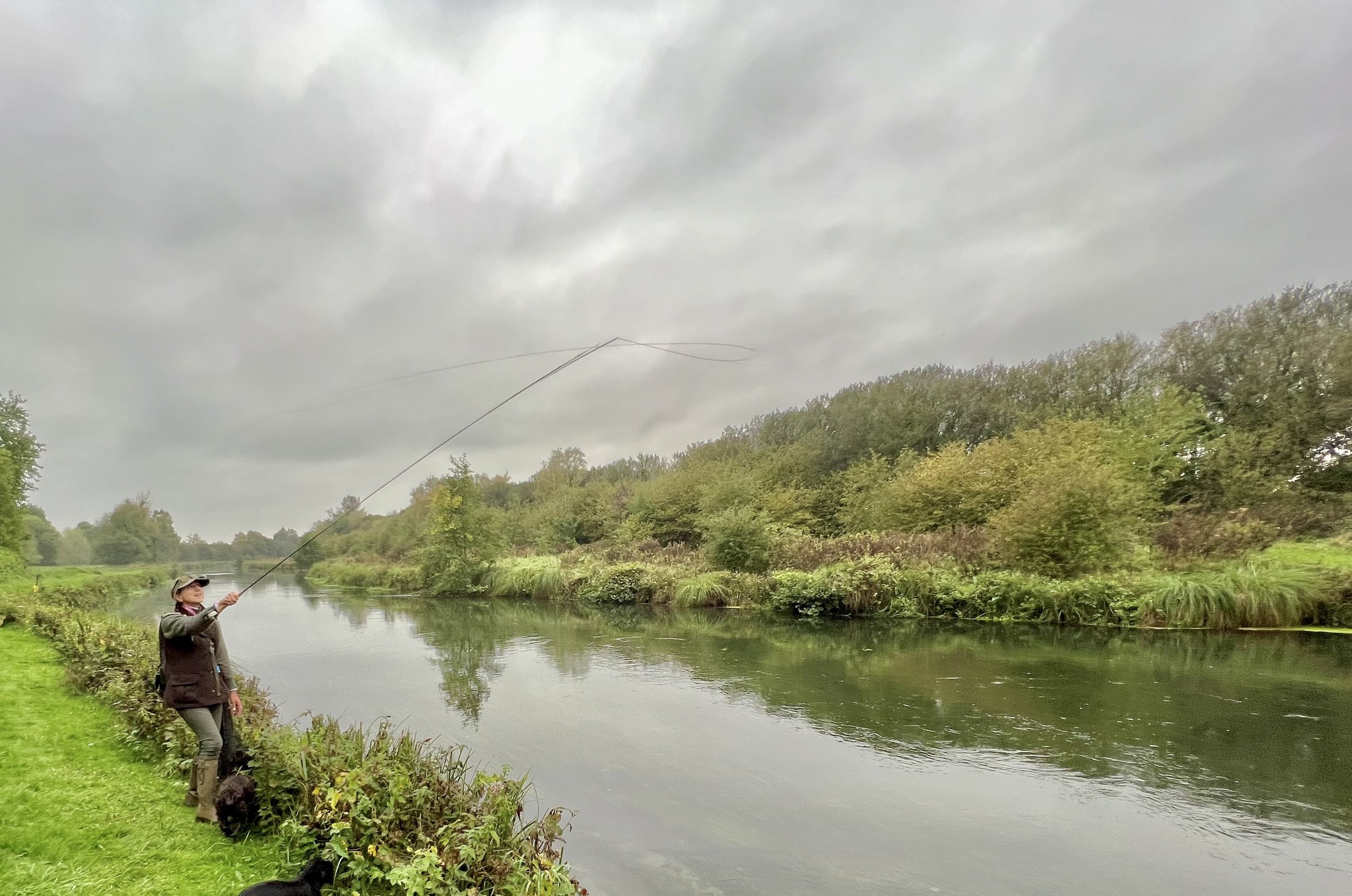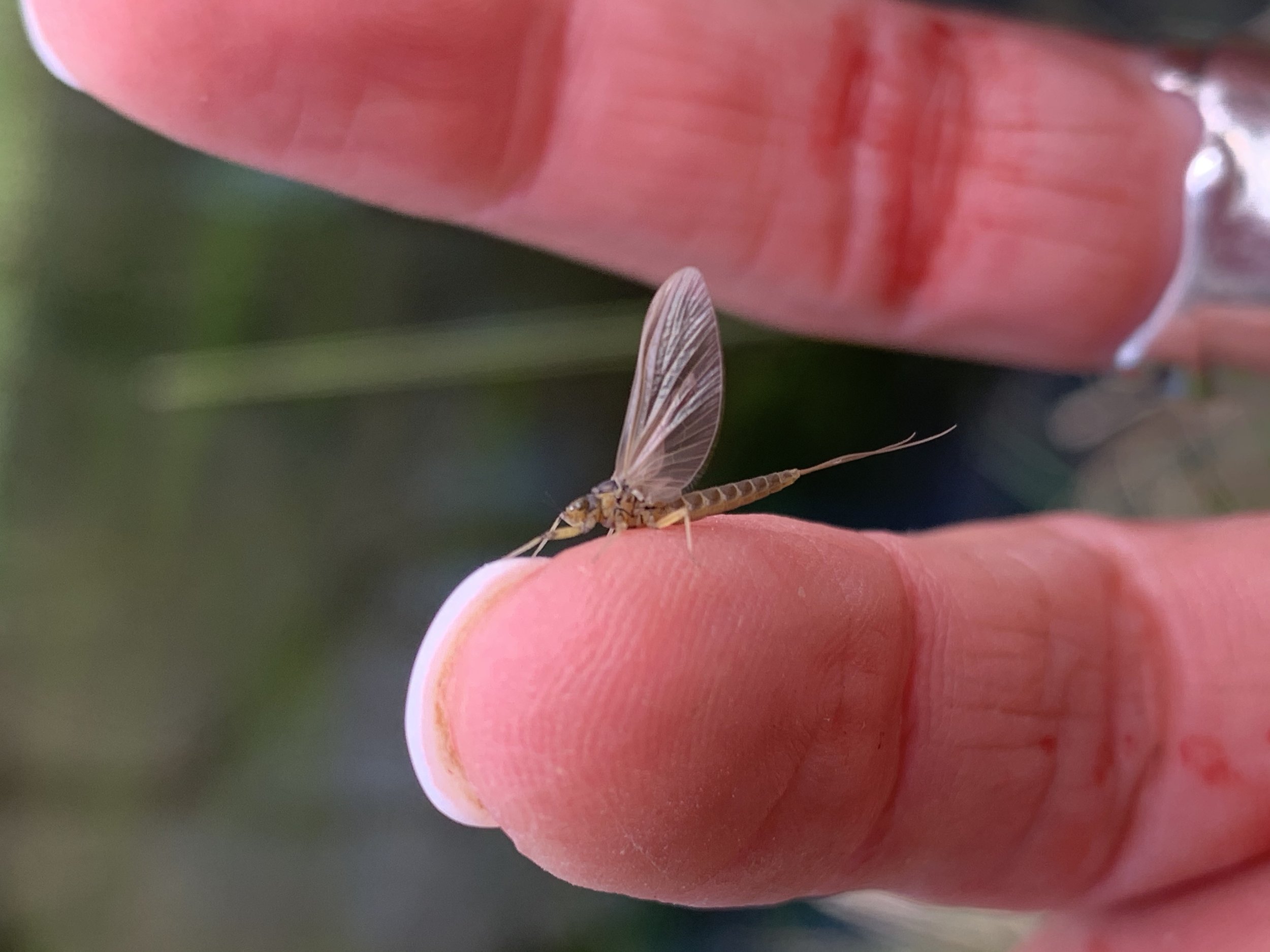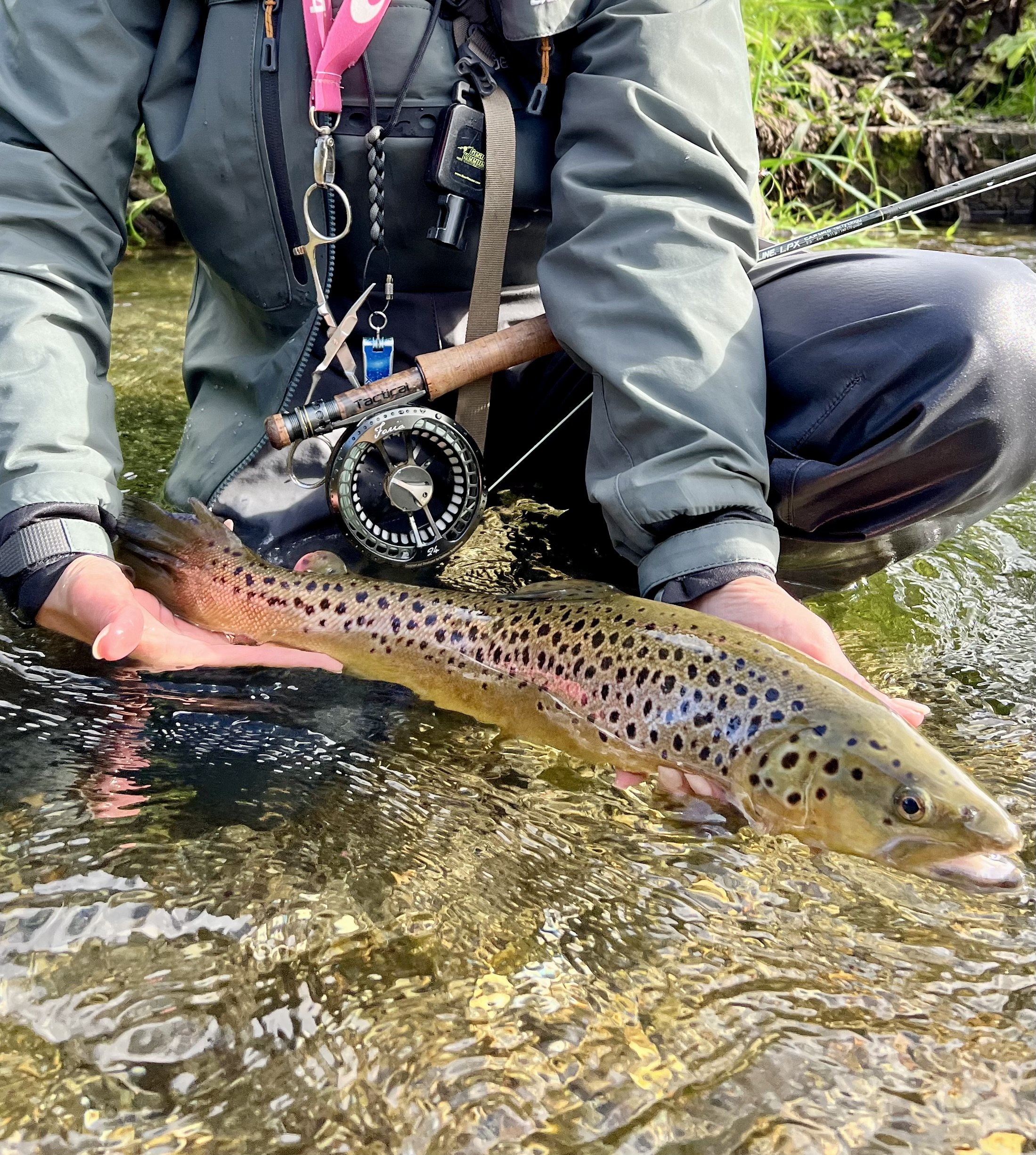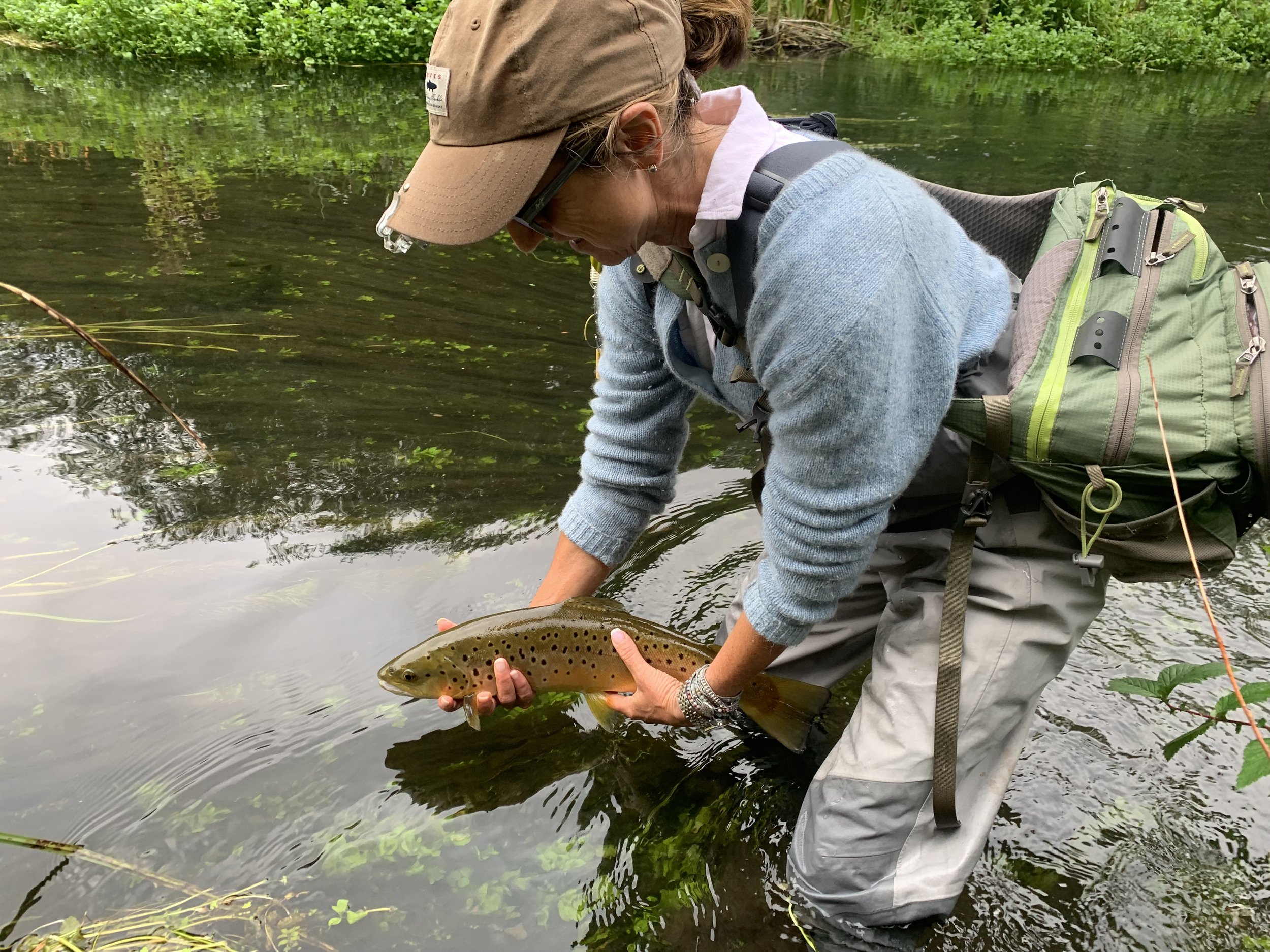
Gilly Bate
1. Choice of equipment. Rods, reels, fly lines, fly float ants, clothes, glasses, and other useful items.
The rod length depends on where I am fishing, but generally, I usually have plenty of room for casting on the chalk streams, so I prefer 9 ft 6 up to 10 ft. They are so much easier for adding in mends, for distance, for high-sticking nymphs, and for keeping over the top of bank side vegetation.
For river fishing, I prefer a high-end medium action rod. I like a rod that can bend well in the tip when using light tippets, and I also like to flex deep into the rod for distance and for playing big fish.
And I like a lightweight rod. My preferred rod this season has been a 9ft 9 4-weight Guideline Tactical rod. It covers all of the above attributes. I don’t think the reels for trout are really that important, but I like a reasonably decent sized arbor so that I am not whizzing my hand at speed trying to retrieve fly line. I like reels to look pretty, and I have a bit of a thing for the engineering behind the top-end Hardy reels. Totally unnecessary for trout fishing, but they look, feel, and sound beautiful. Fly Lines are so very important, and often overlooked. The marriage of rod and fly line can be a thing of joy or not. For the Guideline rod above I have it matched to a Fario CDC WF flyline, and it is a lovely set up to use. Generally, I like a fly line with a long front taper for delicate presentation of dries. Some tapers are chunky in the head, and they almost unbalance the rod when you are casting. I’m looking for smoothness and the two working in harmony together. A long back taper is excellent if you want to hold up a lot of line for distance, but it’s not something I generally need for chalk stream. Many fly lines are heavier than they say on the box, so you need to be careful. I have a few rods that I deliberately underline with certain fly lines, and I end up with a much better sensitivity of the cast.Another lovely line to use is the Rio Technical fly line with its long front taper but I prefer it a size down. I use a heavier weight line when I am fishing on small streams with a lot of overhanging vegetation where I am only casting at very short distances and using my zero weight rod!
Floatants: I use Orvis silicon floatant for general dry fly use, and I like Hunters original floatant for
use with CDC patterns.
Clothing: General muddy-coloured clothes with dull hats. Waders: Guideline and Guideline boots are the lightest and most comfortable. Wading Jacket: Guideline and I love the Loft jackets for lightweight wear and warmth.
Glasses: Sadly, I now need prescription distance lenses and I absolutely love my Maui Jims. They have superb polarisation for sight fishing. I prefer a pack to a fishing vest. They are easier to access, and I can swing it behind me out of the way when I am fishing. Slim fishing boxes are best as you don’t bulk up, and I like bright red ones as they are much easier to find if you drop them!
I use an extendable folding soft rubber bucket net. They have an extended reach and are easy to put on your back. I like the bucket shape as it is much kinder on the fish. I also carry forceps and snips, plus a container for used nylon. I have a great little gadget called a ‘flyback’, which is easy to use if you get a treasured fly stuck up
a tree. You attach it to the top ring of the rod, hook it over the branch, and then pull the strong cord. Brilliant.
For drying CDC feathers on flies, Kleenex is by far the best method.
2. Leader material, build-up, length and knots.
I use Orvis tapered leaders for most of my clients. Two in a pack, size 4X and 5X. 9 ft for early season and 12ft leaders from the end of June onwards.I add tippet material to lengthen as they get shorter, and if I need to drop down a size and extend the leader. I use a simple Surgeons knot to add tippet. I'm not keen on the Orvis tippet as I find it unreliable, so I carry Preston Innovations Reflo Power Mono. It is very strong, very supple and soft. It has never let me down, even on sizeable fish at lighter-breaking strains.
I love Stroft Leaders and tippet, but I buy these for myself as they are pricey. They are super soft and supple and very strong. You can buy 12- and 15ft leaders ready-made in various breaking strains.
I prefer nylon over flurocarbon for dry fly, but I like it for nymphing.
3. Approach and Stealth
From the moment you arrive at the beat, you should be looking out for any insect activity: in the air, on the water, checking out bushes for beetles or any bugs that might be falling into the water. The obvious one is looking for cobwebs on bridges/fishing huts, etc. Trapped insects give a good indication of what’s been happening over the last few days. Always take time before you start fishing and observe the water - not necessarily looking for trout, but checking for any insect activity and looking for seams in the water, foam lines, where the primary current will be bringing down food to the fish. Slow down. The fish will see you as soon as you see them, but often, by standing still, they start to accept you as part of the environment; they soon start to relax and ignore you. You can get closer than you think by taking more time. Too many anglers rush up the river bank, frightening fish and missing others. Often, they can be very close to the edge, and you’ll see them at the last minute as they take off at speed. Have slow movements and avoid overcasting; one cast is often enough. Always consider the fish and its feeding; is it prepared to move to take the fly or only rising in one particular spot? Always check behind you before you cast, and look for any obstacles you must avoid. So often, the first cast is the most likely to catch the fish.
4. Reading the water
Try to think like a trout. Where will a fish feel safe, where is there a good food supply? Consider the speed of the water. Look for the main current and consider its flow rate. Fast means good oxygen, so often, trout will be in the depths below, where the current runs slower. However, this can be tricky with your fly rushing at speed, so you may need to slow down the movement by adding a mend or reach cast. Slow water can be very tricky, too, as the fish are more aware of the fly line landing, so lengthen your leader to keep the fly line as far away from the line as possible. Always search out foam lines and food channels. Overhanging vegetation usually
has trout lying underneath, so it can be a good call to flick a fly where many wouldn’t bother, andit often pays dividends.
5. Casting ability - which casts are essential
The more casts you can execute, the better your chances of catching more fish, especially the tricky ones.
Quiet casting is essential! I want the fly to land gently on the water, and you certainly do not want any splashing or ripping of the fly line as you lift it off the surface. I cannot emphasise the importance of mastering basic casts such as the overhead and roll cast to the best of your ability. Often, your first cast is the one that catches the fish, so ensure that you do it well and refrain from false casting over the fish too many times.
Good tracking is essential to learn and often overlooked, resulting in a poorly placed fly. Move your hand in a straight line, regardless of the plane. Presentation casts are vital to slow down the rate at which the fly moves with the current. Your fly should move naturally with the current, and any drag is one of the main reasons for a
refusal. Casting over your opposite shoulder is one of the hardest things for many anglers. For example, you are right-handed and on a true left bank. It is such a vital cast to practise and so often necessary. Another cast that many find tricky is when a fish is very close to the bank, and you have to side-cast. For some reason, many anglers cannot take the hand in a straight line as they drop the plane, and the fly often lands nowhere near the fish. A handy cast is a curve cast whereyou can flip the fly into a bend in the river or into a pocket. I also double-haul most of the time. Mainly because I’m lazy, and it gives me tension without trying, and it is so handy if you want to shoot a little line on the forward cast.
6. Entomology: what should we know
The more you know, the better. Presentation is important, but the fish can be highly selective on the chalk streams, and a decent understanding of fly life can make a big difference to your day. Identifying upwing flies does not need to be exact, so various patterns of different sizes and colours are a good starting point. Generally, they start size 14 in the Spring and drop down to 18, 20 or even smaller in the later summer months and Autumn. Trout will always go for the easier option, so an emerging fly will be taken much more readily than
a dun about to take off. Sedges start small with grannom in the early season to large cinnamon sedge in the Autumn. Purchase a variety of cream, black, grey and red sedge patterns in different sizes. Terrestrials are often overlooked, and you will have great sport if the fish are hitting hawthorn flies, beetles, or even flying ants. They go crazy for them and occasionally lock onto something unusual, such as hoverflies or bright blue damsels flitting over the water. It is essential to recognise the various stages of aquatic invertebrates to decide which pattern to use, and when. Many anglers use nymphs that are far too big and brightly coloured. Think slim and small. A good starting point are pheasant-tailed nymphs in various sizes, some weighted, some not. Small shrimp patterns are the same. Heavy nymphs are perfect for deep, fast water to reach the fish. Caddis patterns are usually down in the depths.
7. rise forms. Can they tell us something?
Rise forms give us clues as to likely patterns to use. If they are sub-surface nosing and diving, then they are feeding on emerging flies, so look out for insects in the air. You can then use an emerger pattern. A fly with its bottom dropped in the water. Proper rises where you see a large ring after the rise means they are feeding on duns taking off where a true dryfly usually works, but they will still like emerger patterns. Sipping or kissing the water indicates spent patterns with the fish languidly taking the fly. The fly has died, so there is no urgency for the fish to grab it off the surface. Flies taken at speed when you hear slashy rises usually indicates sedge feeding. Also, sedge tend to be an afternoon to evening fly. Terrestrials will often struggle in the surface film as they try to get off the water, so observation is key.
8. Fly Selection: size, shape, materials, which flies are essential
I have to confess to tying very few flies; I don't have the time, so I regularly use these selections from Fulling Mill. I particularly like their river Tactical range. For the Rivers Test and Itchen, I would recommend the following as a good starting point:
Procter's Pearly Butt Olive Emerger - an absolute essential for emerging olive patterns
Retirer Hi Vis Sedge - a great sedge pattern
Procter's All Purpose Terrestrial -when you are unsure what they are taking, but they look small and dark.
Drop arse spinner olive - a fantastic fly on spent flies in the summer months.
Parachute Adams - a great all-rounder - start with size 14 in the spring and drop down to size 20
in the late summer.
9/ Presentation and drifts
Presentation of the fly onto the water is everything, as anything untoward will prevent the fish from taking the fly. The fly must move naturally with any current. Even small currents affecting the fly line and leader can promote drag on the fly, and an instant refusal. Learning how to cast some slack into your presentation of the fly is essential by using slack line casts. A reach cast is easy to learn and buys you valuable time in a drag-free drift. Aerial mends do the same. Even dropping the rod tip as the fly line is unrolling can put little wiggles of slack into the system and make a difference. Wiggling the rod as the loop is unrolling can also help, but be aware that you must shoot line. Otherwise, your fly will land short. All of these casts take time to perfect as you still need to be able to place the fly exactly where you want it. I am looking for a nice drag-free drift with emerging patterns, duns or spent patterns. The only time I will cast a fly directly close to the fish is when I am looking for an instant reaction, such as when fishing any sedge patterns which land and take off very quickly, so the fish are quick to respond.
10. Upstream or downstream
My fishing is predominantly on the English chalk streams, where downstream fishing is almost considered a hanging offence. It’s so drilled into me that even if I am grayling fishing, I find it hard to drift the fly downstream. I also like the control of upstream or across, where I can easily manipulate the line. Downstream isn’t so easy, but probably because It is not something I usually do.
11. Fighting fish.
I like to get fish onto the reel super quick and get a hold of them so that I am in control and not the fish doing what it wants. However, with lighter tippets on occasion, you can only sometimes bully them, and it's all about manipulation. One of the biggest mistakes I see with people is letting the fish take off at speed and taking out a lot of line. Too much slack usually ensues with the fish spitting out the fly. Fish are also quite good at diving into any vegetation, particularly the bank side, so it is essential to hold the rod out at an angle to prevent this. A longer rod makes this a lot easier to manage. Also, try not to hold the rod straight up. This only engages the rod's tip, resulting in little pressure on the fish. If you point the rod slightly down towards the fish, you start to engage more of the rod, which results in more more pressure on the fish. An important point is to use strong enough leaders and a strong enough rod to bring fish in quickly, for catch and release, especially in hot weather were you have less dissolved oxygen in the water.
